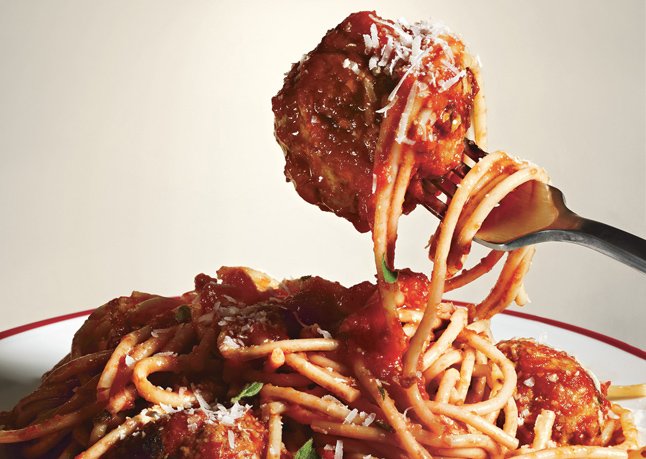By Danielle Walsh, Bon Appétit

It seems like every Italian grandmother has her own secret for the perfect meatballs. Some soak their breadcrumbs in milk. Some use a special blend of herbs and spices. Some combine different types of meat for that oh-so-perfect texture. But if you're not a nonna, meatballs can be difficult. It's tough to get the texture right, how to tell if the meat is seasoned enough, to sear them for the right amount of time. Too often, they come out spongy, dry, and dense.
We're here to help! We asked Assistant Food Editor Alison Roman for the most common mistakes people make when serving up a plate of spaghetti and meatballs, and she shed some light on the art of mixing, rolling, and cooking these little balls of meaty joy.
SEE MORE: The Ultimate Chocolate Chip Cookie
1. Meatballs need to be seasoned, period. As a rule, about 1 teaspoon per pound will make for perfectly salted meat. If you're using a salty cheese like Parmesan in the mix, cut back on the salt a little bit. You don't want your balls to be too salty.
2. Herbs! They're an important part of your standard Italian-style meatball mix. Without them, your meatballs will end up tasting like a burger. But don't feel like you have to be married to parsley or basil. Mix it up with herbs like mint, oregano, and marjoram. Add a pinch of nutmeg, too--it adds a subtle depth of flavor that will make guests ask, "What is that?" (in a good way).
3. Eggs are not a source of moisture! They're in the meatball mix to bind the meat, breadcrumbs, cheese, and herbs. The eggs will cook and make the meatballs dense and spongy--you want light, airy meatballs. For one to two pounds of meat, you usually won't need more than one or two eggs. And make sure not to add too much breadcrumbs, either--about a half cup per pound of meat will suffice.
4. When you're ready to mix it all together, make sure to put all the ingredients into a bowl at once and always use your hands to mix them. The light touch of your hands incorporates all of the ingredients without crushing the meat. You don't want to over-mix into a paste--full pieces of ground meat should still be visible.
5. Depending on how you'll serve the meatballs, you should roll them to the size appropriate for the dish. In soup, for instance, you'll want smaller, bite-size meatballs. If they're served on their own, they should be pretty big, like 2 inches in diameter. If they're on top of spaghetti, a medium meatball will suffice. This one is all about preference, but just consider how the balls will be eaten.
SEE MORE: Want to Know What Chef Bobby Flay Eats for Breakfast?6. If you roll your meatballs with dry hands, the meat mixture will stick to your skin and make rolling a ball impossible. To remedy this, lightly oil your hands. You'll only need a light rolling motion to form a (not too tight!) ball.
7. It's always best to be as clean as possible in the kitchen--especially when handling raw meat. Line a lipped sheet pan with parchment, and place meatballs neatly onto the tray for no mess and no roll-away meatballs.
8. There's a reason nobody ever poaches beef--you don't get nearly as much flavor as when the meat hits a hot pan. Sear the balls for a nice brown crust (if you're cooking for a crowd, space the meatballs out evenly and just throw the pan into a hot oven for the same effect), then braise them. It's really hard to overcook them in your sauce, since they're sitting in liquid. Braise them for about 15-20 minutes, or until you're ready to serve them.
Get the recipe: Spaghetti and MeatballsMore from Bon Appétit:25 Ways to Use Sriracha